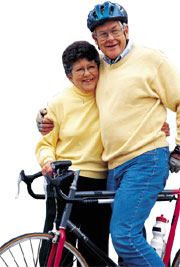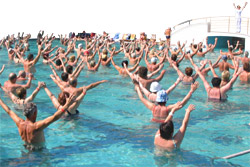- Introduction to physical activity with cardiovascular disease
- Why is physical activity important?
- Health benefits of physical activity
- How much physical activity is enough?
- Who should engage in physical activity?
- How hard should I do physical activity?
- What sort of physical activity is best?
- Is there any assistance available to help me get started?
Introduction to physical activity with cardiovascular disease
Maintaining appropriate levels of physical activity with cardiovascular disease is now thought to be very important. We now know that people who take up regular physical activity after an initial cardiac event (such as a heart attack), and who have stable disease symptoms, have a 31% lower risk of experiencing another, fatal cardiac event – when compared to those people who don’t engage in regular physical activity. New recommendations from the National Heart Foundation of Australia have recently become available, suggesting how much and what kind of exercise might be most helpful for these people. Old advice to ‘take it easy’ has gone out the window in favour of new recommendations to ‘get physical – in a moderate way’!
Why is physical activity important?

The problem of insufficient physical activity is likely to be even worse for those people who already have existing cardiovascular disease. This may be partly because they are simply continuing with the sort of lifestyle that contributed to their developing the disease in the first place. However, it may also be because of some past confusion about whether or not exercise is good for people with known CVD. Many people may have first experienced symptoms while exercising or being otherwise stressed, and are naturally cautious about any future exercise. New research, however, has shown that exercise in this group is not only possible, but very important for improving people’s health. Even better, we know that the amount of activity required to attain health benefits is achievable.
Health benefits of physical activity
- Improved prognosis – longer lives troubled by fewer symptoms;
- Improvement in many of the risk factors that we know may lead to worsening of CVD (lower blood pressures, better blood lipids and cholesterols, improved insulin resistance and glucose intolerance – which is to say improvement in diabetic health – and less obesity);
- Less angina (cardiac chest pain); and
- Possibly a reduction in the occurrence of depression following a heart attack.
How much physical activity is enough?
- Aim for at least 30 minutes of moderate activity on most days of the week. This is the same amount of exercise that every healthy adult needs.
- The exercise doesn’t have to be done all at once. Try three lots of 10 minutes every day instead – it’s just as good for you as 30 minutes at once, and will be much easier to start with.
Who should engage in physical activity?
- Everybody! Young or old, male or female, everyone needs to be physically active.
- You are never too old to start exercise. The rate of CVD is much higher in older Australians, so it is even more important that these groups of people keep active.
How hard should I do physical activity?
The physical activity shouldn’t be too strenuous, especially to start with. Try walking at a pace that makes you breathe a bit faster, but not so fast that you can’t still hold a conversation.
- If you’re not used to doing exercise, it’s best to start slowly and build up your fitness. Start with short bouts of light activity, such as a slow ten-minute walk, and then slowly make the walk longer until you can manage half an hour at a time. When you’re comfortable with that, pick up the pace a little. Remember, don’t try to do too much when you’re just starting out.
- If you have severe CVD, are elderly, have difficulty managing normal daily tasks, or have a non-cardiac sort of CVD like peripheral vascular disease, stroke, or diabetes, speak to your cardiologist before starting any sort of exercise program.
- If you develop any symptoms like chest pain, difficulty breathing, dizziness, nausea or excessive sweating, stop the activity and see your medical practitioner.
What sort of physical activity is best?
- Most of the studies so far that have looked at exercise in people with CVD have focused on formal ‘endurance’ exercise like walking, cycling and swimming. Any or all of these are good for your heart.
- Physical activity doing things like housework or gardening may not necessarily have the same benefits for your health as ‘endurance’ exercise – they may not, because most of these home tasks involve only very short bursts of activity between periods of rest. So while you should keep up these tasks as long as they don’t cause you any symptoms, they don’t count towards your 30 minute total.
- Weightlifting, a type of ‘resistance exercise’, is also not quite as good for your heart as endurance exercises like walking or swimming. But weightlifting can still be good for you if done alongside a type of endurance exercise, because it can help build and keep up muscle strength, which in turn can make daily tasks easier. If you plan to start weighlifting, though, it is best to do so with the help of an exercise professional – at least to start with.
- The most important thing is to find a type of exercise that suits you and that you enjoy. This way, it’ll be much easier to keep it up.
- Maybe try cycling with a group of friends, or walk to the shops instead of driving. There are many opportunities every day to get active if you look out for them.
Is there any assistance available to help me get started?
- Some hospitals and community groups offer special outpatient cardiac rehabilitation groups which can help you get started on a safe and healthy exercise program.
- Another option is talking to your GP. They may be able to refer you to someone who can work out an exercise ‘prescription’ that will work best for you.
Kindly contributed by Dr Andrew Maiorana, PhD, Senior Exercise Physiologist with the Cardiac Transplant Unit at Royal Perth Hospital. He was a member of the Executive Working Group responsible for writing the National Heart Foundation of Australia physical activity recommendations for people with CVD.
References
- Australian Institute of Health and Welfare (AIHW). Heart, stroke and vascular diseases – Australian facts 2004 (Cardiovascular Diseases Series No. 22). AIHW and National Heart Foundation of Australia, 2004.
- Blumenthal JA, Babyak MA, Carney RM, et al. Exercise, depression, and mortality after myocardial infarction in the ENRICHED Trial. Med Sci Sports Exerc 2004;36:746-55.
- Briffa T, Maiorana A, Allan R, et al. On behalf of the Executive Working Group and National Forum Participants. National Heart Foundation of Australia physical activity recommendations for people with cardiovascular disease. Sydney (Australia): National Heart Foundation of Australia; September 2005.
- Briffa TG, Maiorana A, Sheerin NJ, et al. Physical activity for people with cardiovascular disease: recommendations of the National Heart Foundation of Australia. MJA 2006;184: 71-5. Available from URL: http://www.heartfoundation.com.au/ downloads/ PAR4CVD FullRecs 06_Jan_final.pdf
- Hambrecht R, Walter C, Mobius-Winkler, S. Percutaneous coronary angioplasty compared with exercise training in patients with stable coronary artery disease; a randomised trial. Circulation 2004;109:1371-8.
- McKelvie RS, McCartney N, Tomlinson C, et al. Comparison of hemodynamic responses to cycling and resistance exercise in congestive heart failure secondary to ischemic cardiomyopathy. Am J Cardiol 1995;76:977-9.
All content and media on the HealthEngine Blog is created and published online for informational purposes only. It is not intended to be a substitute for professional medical advice and should not be relied on as health or personal advice. Always seek the guidance of your doctor or other qualified health professional with any questions you may have regarding your health or a medical condition. Never disregard the advice of a medical professional, or delay in seeking it because of something you have read on this Website. If you think you may have a medical emergency, call your doctor, go to the nearest hospital emergency department, or call the emergency services immediately.

 The physical activity shouldn’t be too strenuous, especially to start with. Try walking at a pace that makes you breathe a bit faster, but not so fast that you can’t still hold a conversation.
The physical activity shouldn’t be too strenuous, especially to start with. Try walking at a pace that makes you breathe a bit faster, but not so fast that you can’t still hold a conversation.





